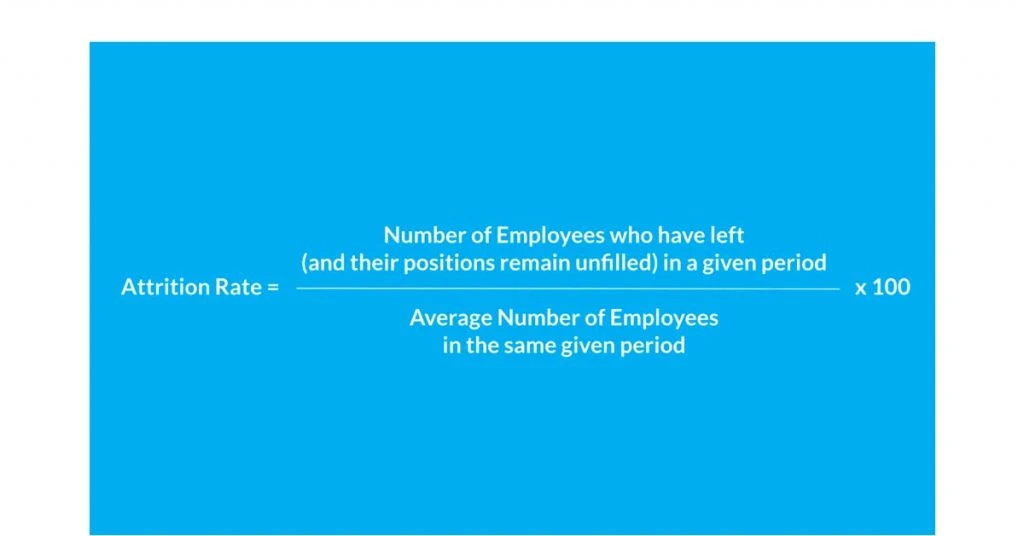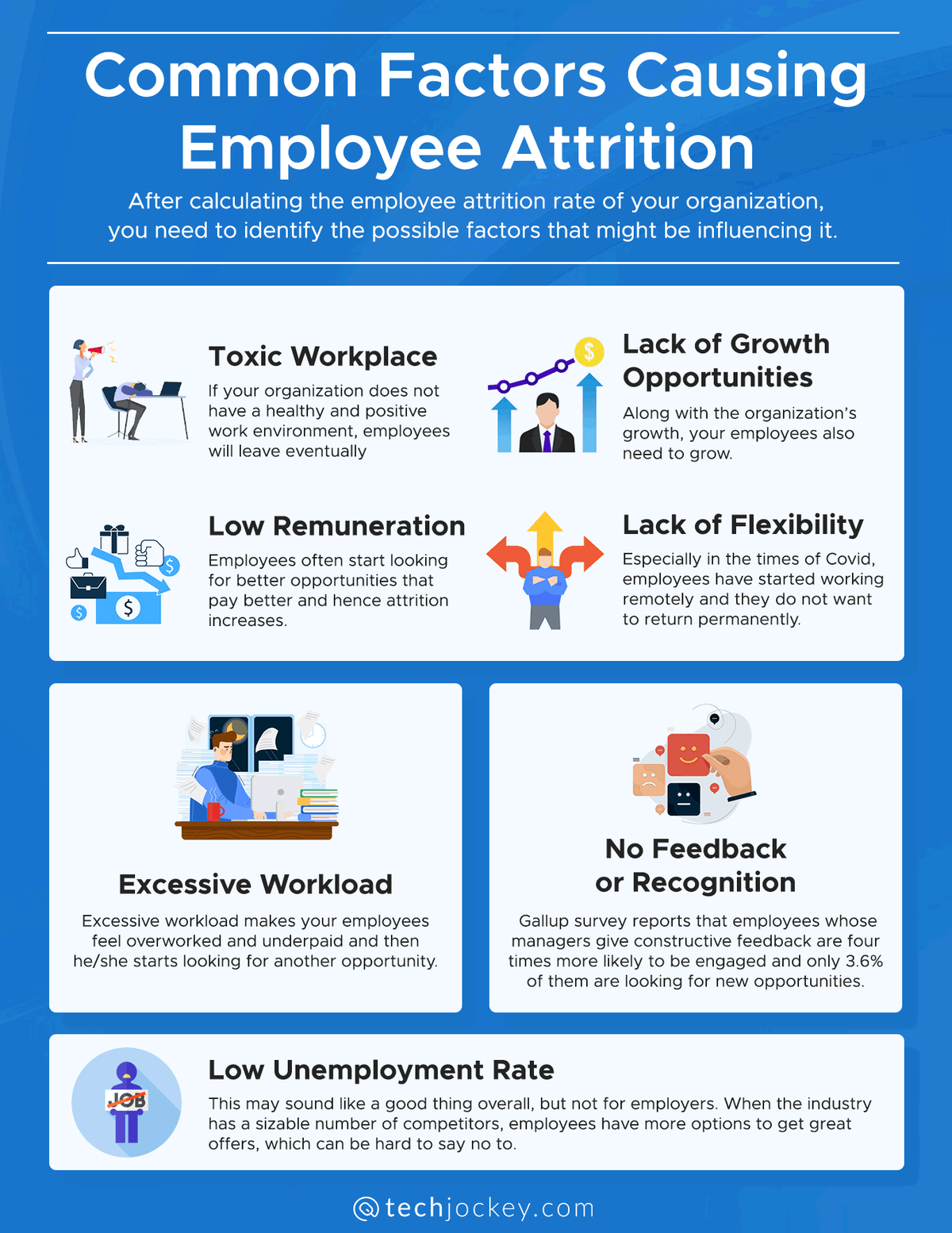Employee Attrition and Why its Important: All You Need to Know

It is important to leave one place and move to another for growth. The same applies to a professional journey as well, but it is not the same in the case of an organization. Any employer would want their employees to stay with their company for a long time. Any employee leaving the organization abruptly adds up to the attrition rate.
In this article, we will understand the concept of employee attrition, why it matters to organizations.
What Is Employee Attrition?
Employee attrition meaning is when an employee leaves the organization due to unpredictable or uncontrolled reasons and their replacement is not available for a long time. The reasons can be anything like long-term sickness, grievance with the existing setup, layoffs, voluntary retirement, or even death.
Employee Attrition Vs Employee Turnover
Employers often confuse employee attrition with employee turnover. Although both the scenarios mean that employees are leaving the organization but in the case of turnover, the employer finds a replacement in real-time. Whereas in employee attrition, the position remains vacant or even gets eliminated after some time.
Employee turnover helps you in measuring the rate at which you are replacing and filling the employees that take exit from the organization. The exit can be influenced by voluntary or involuntary factors, but the employee gets replaced soon.
To calculate your organization’s employee turnover rate, you can divide your average head count with the total departures and multiply the same by 100 to derive the percentage.
Employee Turnover = (Total Departures/ Average Headcount) X 100
However, in the case of employee attrition, again the factors influencing the exit can be voluntary and involuntary like resignations, or retirements with age, but here the employee will not be replaced.
Higher attrition in the organization means that the organization is aging and it needs knowledge transfer and younger people in higher positions.
Recent Employee Attrition Trends

In the post COVID era, a phenomenal trend called “The Great Resignation” has emerged in the market. Employees are voluntarily resigning and employers are trying hard to retain their top talent.
During the pandemic, people were facing unemployment, uncertainty of jobs, and layoffs, but now the situation has reversed.
When an employee does not feel valued at work, he or she starts looking for another job opportunity. Around 76 percent of employees agreed to this fact that they would stay longer with an organization if their inputs are valued.
Especially in the technology and healthcare sector, many employees in the middle of their careers are resigning voluntarily.
Suggested Read: Most Effective Employee Retention Strategies for Today’s Work Culture
But the big question is WHY?
Employees are now looking for more than just a good pay. They now want something that suits their lifestyle in the new normal. Employees still want to work for their companies but do not want to give up on their family and passion. They want to work for organizations that understand and support their alternative lifestyle.
Failing to do so is costing employers a fortune. The hiring process includes posting advertisements, hiring agencies, recruitment, onboarding etc. which adds up to the cost. On an average its costs an employer 33 percent of an employee’s salary to manage his/her exit. So, employers should focus on retaining employees to reduce their costs and to reduce attrition rate.
What Are The Different Types of Employee Attrition?
There can be several reasons why employee leaves the organization like voluntary resignation, layoffs, retirement, etc. Based on these, employee attrition can be classified in five major categories:
Voluntary Attrition: It is a scenario in which the employee chooses to leave the organization after resignation. The reasons for voluntary attrition can be your employees getting better opportunities, unable to cope with the work pressure, or finding new ways to ensure work-life balance.
Attrition Due to Retirement: Quite often, two or three employees may retire every year from your organization, but if this number is high, it will add up to the attrition rate. If your employees opt for early retirement or become independent consultants to your organization, then there may be other factors that are influencing this decision other than age.
Involuntary Attrition: In this scenario, the organization decides to part ways with an employee and end the association. Reasons behind this decision can be layoffs, new openings, termination because of any policy violation, etc. Often mergers and acquisitions also lead to high involuntary employee attrition.
Attrition Due to Demographic Reasons: Employers try to build an equal workspace, but often other employees in the organization may not resonate with this. Look for any trends in attrition if people from a specific group or demographic like religion, caste, or minority are frequently leaving the organization. If yes, then identify the reasons and try to build a positive and encouraging work culture.
Internal Attrition: In this scenario, employees quit one specific department to join another in a limited period. Here, the HR department needs to investigate the reasons like incapable managers or disturbed workflow, etc.
Suggested Read: Leave Management Challenges & How to Resolve
Why Does Employee Attrition Matter?
Knowing your organization’s attrition rate will help you in understanding how employee-friendly your organization is. Higher attrition rate may mean that you are not offering enough benefits to your employees, or they are forced to work in a pressurized environment, or they are not getting enough opportunities for learning & growth.
Apart from this, filling the position of an employee who has spent a sizable number of years in the organization costs a lot of time and money. The recruitment process includes hiring, agency costs, onboarding, etc. which requires investment.
In addition to this, new employees take a lot of time to adjust to the organization’s culture, connect with co-workers, and become familiar with the processes.
Also, when an employee leaves the organization, he/she takes back whatever they might have brought to the table, such as client relations, experiences, personal and professional network, etc. Organizations need to calculate employee attrition rate to save cost, time, and effort.
What Is Employee Attrition Rate?
Employee attrition rate meaning is that it’s a metric through which employers calculate the rate at which employees are leaving the organization. It is used by the human resources department to calculate the number of vacant positions and plan the hiring accordingly. It also encourages them to identify the factors that might have influenced the higher attrition rate.
Suggested Read: Tips to Achieve Higher Employee Engagement in 2022
How to Calculate Employee Attrition?
With the given formula, you can calculate the employee attrition rate in your organization over a given period. Divide your average number of employees in each period with the number of employees that have left the organization and no replacement has been found for them, multiply this by 100 to get the accurate percentage.
Here is the formula for calculating attrition rate for employee:

Common Factors Causing Employee Attrition

After calculating the employee attrition rate of your organization, you need to identify the possible factors that might be influencing it.
- Toxic Workplace:If your organization does not have a healthy and positive work environment, employees will leave eventually. Employees might feel demotivated because of certain policies, pressed work scenario, unsupportive bosses, or behavioral issues. To investigate this, conduct regular 360-degree feedback, where employees fill in a feedback form to rate the workplace and their colleagues. This will introduce you to the areas that need to be addressed.
- Lack of Growth Opportunities: Along with the organization’s growth, your employees also need to grow. Employees get demotivated in a mundane work scenario soon and start seeking individual growth opportunities that upskill them. You can organize training sessions and assign interesting tasks to your employees so that their learning graph never declines.
- Low Remuneration: Employees often start looking for better opportunities that pay better, and hence, attrition increases. Organizations should conduct appraisals, give bonuses, and increments to keep the employees motivated, because replacing them would cost more.
- Lack of Flexibility: Especially in the times of COVID, employees have started working remotely, and they do not want to return permanently. A flexible approach increases your recruitment horizon to hire from a global pool of talent and motivates your current employees to stay for a longer time . When both employers and employees understand and adjust according to each it leads to a long and fulfilling collaboration.
- Excessive Workload: Excessive workload makes your employees feel overworked and underpaid and then he/she start looking for another opportunity. People need to spend time out of their office with their families and friends to maintain a healthy work-life balance. In fact, poor work-life balance is one of the top three reasons why employees leave an organization. Organizations can use tech solutions to automate, manage, and distribute workload so that everyone can adjust to schedules and have enough time for their personal lives.
- No Feedback or Recognition: A Gallup survey reports that employees whose managers give constructive feedback are four times more likely to be engaged, and only 3.6% of them are looking for new opportunities. Recognition makes them feel valued and encourages them to perform better.
- Low Unemployment Rate: This may sound like a good thing overall, but not for employers. When the industry has a sizable number of competitors, employees have more options to get great offers, which can be hard to say no to.
Suggested Read: Looking for Ways to Increase Employees Engagement
Can Attrition Be Beneficial for Organizations?
Is attrition rate always bad?
Attrition is a word that comes with a negative connotation that raises questions about the company, but you know what, it can be healthy too.
It can give you a chance to create a new pool of talent in the organization. The attrition can also be higher because employees can be unfit for the role. For example, if an organization is adopting modern technologies and ways to work, but a few employees refrain from the change, then the attrition rate will be higher.
This is beneficial for the organization as well as the employee. The employee can find a better suitable company for them, and the company can hire more apt employees.
Best Practices to Reduce Employee Attrition Rate

Reducing your employee attrition rate is not that hard. Issues in the organization can be rectified if some attention is paid to them.
- Hiring the right managers: You need to have managers that can train and guide your employees in the right direction. Remember the saying that “employees don’t leave because of the organization, they leave because of the managers.”
- Pay industry-standard salaries: If you are not offering industry-standard salaries to your employees, then your competitors will pay more than that. Do a survey, understand the industry requirements, and revise your employees’ salaries accordingly.
- Listen to your employees: Organizations often take feedback from the managers and co-workers, but it is important to do the same for employees too. You can conduct anonymous discussions with employees to understand any issues that they are facing and try resolving them.
- Give additional benefits: Other than the monetary benefits, give your employees extra benefits that make them feel valued. Give them the freedom and flexibility to work, recognize and reward their efforts, and give importance to their physical and mental health. All this will keep them connected to the organization and instill a feeling of belongingness towards the organization.
- Do the right hiring: For the right hiring, make sure you get a clear picture of the expectations on both ends, i.e., the organization and the candidate. Mean what you say, for example, if you mention it is remote work, but you plan to call your employees to the office after a few months, so make sure that you are clear about it.
- Give importance to mental health: A happy employee will be far more productive than the one with grievances. Organizations need to understand the importance of mental health and support their employees if they are suffering from anxiety, loneliness, or even dealing with someone’s loss. They need to rejuvenate their mental health.
- Cultivate equality and respect: This is a major part of creating a positive and healthy work culture, where irrespective of the hierarchy, everyone respects each other and are treated equally. Every employee’s issue or concern should be treated with the same urgency and importance.
Conclusion
A higher attrition rate is not good for any organization. However, filling the loopholes in your organization is in your own hands. If you keep your employees happy, they will stick around, even in tough times!
FAQs
What is a good employee attrition rate?
10% is considered an Employee Attrition Vs Employee Turnover s a good employee attrition rate for any organization with up to 100 employees.
How to calculate employee attrition rate?
Use the basic employee attrition formula. Divide your average number of employees in a given period with the number of employees that have left the organization and no replacement has been found for them. Multiply this by 100 to get the accurate percentage.
How to deal with the employee attrition problem?
To deal with employee attrition problems, organizations can conduct stay-in interviews, regular employee feedback and surveys to understand the problems faced by current employees.
What is meant by employee attrition analysis?
Employee attrition analysis means analyzing why the employees voluntarily leave, what measures could have prevented them from leaving, and how data can be used to forecast the attrition rate.
Related Categories: HR Software | Payroll Management Software | Attendance Management Software | Recruitment Management Software
Isha’s writing journey started way back in 2018 when she graduated in the field of Journalism & Mass Communication. Since then, she has been writing for all digital and print marketing assets including blogs, editorial reviews, landing pages, emailers, and more. She has contributed her writings to genres... Read more




























